
Much of what follows about the history of Hillcrest Middle School prior to 1940, is from the works of John W. Pell.
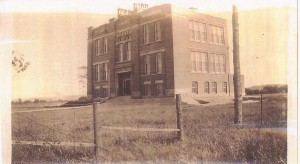 The land in which Hillcrest sits on today was part of the Saltfleet Township when the school was built in 1920. From 1905 to 1915, much of the land surrounding present day Hillcrest was subdivided into lots, and homes were built on these lands by families. The children of these families did not have a school close to them, so their kids had to be sent to Red Hill School, and Van Wagner’s Beach (presently Baranga’s Restaurant). Obviously, this was very far for the children to travel, and these two schools became overcrowded.
The land in which Hillcrest sits on today was part of the Saltfleet Township when the school was built in 1920. From 1905 to 1915, much of the land surrounding present day Hillcrest was subdivided into lots, and homes were built on these lands by families. The children of these families did not have a school close to them, so their kids had to be sent to Red Hill School, and Van Wagner’s Beach (presently Baranga’s Restaurant). Obviously, this was very far for the children to travel, and these two schools became overcrowded.
After some citizens (Joseph Bairstow, F. Gartrell, and T. Lester) applied for a new school to be built, a site was chosen, that was 3/4 mile east of Parkdale Avenue on the south side of Barton Street. Angus McDonnell was the original owner of the land in 1801, and John Ryckman was to his west. In 1875, James F. Gage was the owner of the school site land. His ancestors were one of the first families in today’s Ontario. Gage Park was left by one of his relatives.
Joshua A. Armes, an architect from Hamilton, was hired and construction began in 1919. While the school was to be opened as a four room school, by the spring of 1920, the building was completed just enough to allow the two lower rooms to be occupied. The contractor for this project was the Bowser Construction Company, and the school was valued at $45,000.
At this time, two teachers were hired. Miss Gertrude Eichenburg became Principal, and Miss Florence Eady was her assistant. The opening ceremonies took place after the Easter Holidays in 1920. The school was declared open by Dr. Waugh of Toronto. Also at the ceremonies was the Reeve of Saltfleet, the Mayor of Hamilton, and a school Inspector. In March of 1921, there were two classes opened in the school. The Daily Registers show there were 37 students in the junior classes, and 39 in the senior classes, for a total of 76 students. There were no grades at this time, and classes were organized by forms. For example, there was a Primer Class; Junior 1st and Senior 1st Forms; Junior 2nd and Senior 2nd Forms, etc. Miss Eady taught primer and form one, and Miss Eichenburg taught forms 2, 3, and junior 4th.
The section where Hillcrest was located was called School Section Number Eleven (S.S. No. 11), Saltfleet. This can still be seen on the front of our school today. The township in which Hillcrest was located in 1920, was called Saltfleet. This was not a part of Hamilton. The official address for Saltfleet School Section Number Eleven (Hillcrest) was 2130 Barton Street East.
By the end of the second year in 1922, the school’s population had increased so much that the second floor had to be finished, and one more room was opened. By the mid-1920s, all four rooms had to be used as classrooms.
In the 1920s, twelve subjects were taught: art, household science, manual training, arithmetic, hygiene, nature studies, composition, grammar, history, literature, reading and writing, and spelling.
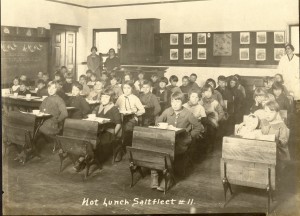 It is important to note before going further that many of the pictures on this site, especially in the history section were provided by former students. The above picture on this page is the only known picture of Hillcrest when it was built in 1920. This was provided to Hillcrest by Mary Moore, a former student, who went to S.S. #11 in 1920 when it opened! Mary also had a sister who went to S.S. #11 at the same time she did. During the early 1920s at Hillcrest, hot lunches were provided for the students by their teachers. At left, there is a picture that shows the hot lunches. This was provided by Mary’s nephew, George Emmons. George also provided a picture from the early 1920’s showing a group of students outside the school.
It is important to note before going further that many of the pictures on this site, especially in the history section were provided by former students. The above picture on this page is the only known picture of Hillcrest when it was built in 1920. This was provided to Hillcrest by Mary Moore, a former student, who went to S.S. #11 in 1920 when it opened! Mary also had a sister who went to S.S. #11 at the same time she did. During the early 1920s at Hillcrest, hot lunches were provided for the students by their teachers. At left, there is a picture that shows the hot lunches. This was provided by Mary’s nephew, George Emmons. George also provided a picture from the early 1920’s showing a group of students outside the school.
In 1929, the Hamilton Civic Airport (Municipal Airport) was opened in what is now the area between Hillcrest and Parkdale Avenue. The airport was built behind the school extended to Parkdale Avenue, and would have came within a few hundred feet of the school today. The airport was built by International Airways Ltd., and the Hamilton Aero Club. The first air mail left on Friday June 7th, 1929.
In July of 1937, $22,000 of debentures were authorized to be sold in order to build a new edition , which was to have four more classrooms, and two basement rooms. Construction began in August of 1937, and was completed in January of 1938. These four rooms are behind the the original four classrooms, and cost $22,000. Some new features included: automatic furnace, water-flush toilet system, terrazzo floors on all floors and landings, and a new office. Frederick W. Warren, an architect from Dundas, Ontario carried out these school improvements. The contractor was H.C. Cummo. The official opening for these rooms was on June 10th, 1938. In 1938, one of the classrooms was used for Manual Training, and another was used for hot lunch preparation. In 1939, a seventh room was equipped for a class.
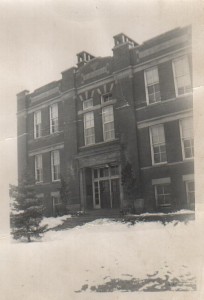 The City of Hamilton annexed a large area of the school population in 1943, so the school population decreased. The number of rooms needed decreased from nine to five in September of 1943. The school population increased in 1944 so much, that on February 1st, a sixth room had to be reopened.
The City of Hamilton annexed a large area of the school population in 1943, so the school population decreased. The number of rooms needed decreased from nine to five in September of 1943. The school population increased in 1944 so much, that on February 1st, a sixth room had to be reopened.
Here are a few class pictures from the 1940s, that were provided to Hillcrest by Ida Nault, a former student who went to Hillcrest from 1938 to 1946. Grade 1 Class of 1944, Grade 3 Class of 1944, Grade 5 & 6 Class of 1946, Grade 7 & 8 Class of 1946, Another former student named Marjorie Dawson has provided us with the name of every student in the above 1944 Grade 5/6 Picture.
During the war years of 1944-1945, students at Hillcrest received two Quota Flags, and a Gold Star for their amazing efforts in their War Savings. The students gave a total amount of $1,441.93. Dan Harris, a former student at Hillcrest, donated this War Savings Certificate to Hillcrest in February 2003. Dan received this certificate in November of 1944.
In the summer of 1945, the interior of Hillcrest was painted. Also, all of the classroom’s were re-wired.
On parents night on May 31st, 1946, the schools Honour Roll for World War II was unveiled. This piece of work was done by A.J. Casson, who was a member of the famous Group Of Seven Artists. This can still be seen in our school today. This contained a list of students who answered the call to war for Canada.
On January 1st, 1948, Hillcrest became a part of School Section Number Two, Saltfleet. On January 1st, 1949, Hillcrest stopped belonging to Saltfleet, as the school was annexed by the City of Hamilton. All of the teachers, and equipment were to come with the school. The school was now a part of the City of Hamilton.
In July of 1953, some Hillcrest parents threatened to “strike” by not sending their children to Woodward School for September classes. These Hillcrest parents, who mainly lived on Brunswick Avenue, thought it was too dangerous for their children to walk to school with all of the traffic on Woodward, and also no sidewalks on the street as well. Also, there was no bus route to Woodward School. Joseph McLaren, who was the trustree for Ward 7, stated that he would discuss with Board of Education officials the possibility of these students remaining at Hillcrest temporarily.
Also in 1953, a second addition was started, and it was used for the first time in September 1954. This added nine classrooms, play-assembly room, principal’s office, gym, and health office. The general contractors were Canadian Engineering. William R. Souter and Associates was the architect. This addition was so big, that it made the newspaper. In the September 1st, 1954 edition of the Hamilton Spectator, it was stated that, “Addition Bigger Than Original School.”
The third addition to Hillcrest was started in 1955, and occupied in January of 1956. This consisted of eight classrooms, including a shop, home economic, art, speech, science, music, and library. The shop ceased to be used in the mid 1990s, and was dismantled in 2002.
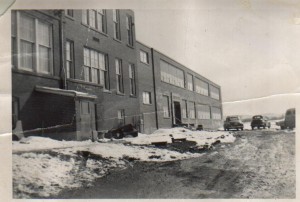 The second and third additions were officially opened on Wednesday April 11th, 1956. Among those in attendance was Lloyd D. Jackson, Mayor of Hamilton, Mr. Vern N. Ames, Superintendent of Public schools, as well as many former principals, and trustees. Hillcrest was built mainly in four stages. It is interesting to note that although stages two and three were built separately, they were opened together. Because of this, many people falsely believe that Hillcrest has only had two additions (1937 and 1956).
The second and third additions were officially opened on Wednesday April 11th, 1956. Among those in attendance was Lloyd D. Jackson, Mayor of Hamilton, Mr. Vern N. Ames, Superintendent of Public schools, as well as many former principals, and trustees. Hillcrest was built mainly in four stages. It is interesting to note that although stages two and three were built separately, they were opened together. Because of this, many people falsely believe that Hillcrest has only had two additions (1937 and 1956).
Hillcrest was given credit for starting an annual checkers tournament that has been held by the Board of Education. In April, 1961, some Hillcrest pupils entered the Ontario Checker Association’s Easter Tournament at the Y.M.C.A. The tournament organizers were surprised by their participations, and their excellent calibre of skill. This led to many individuals calling for a inter-school competition to be set up. Because of these Hillcrest students, in 1997, the Board of Education celebrated the 25th anniversary of it’s annual checkers tournament.
In 1962, the Canadian Government decided to put an air raid siren on Hillcrest, so that it would warn people of missiles that were being fired over the area, and to get in their bomb shelters which were located three feet underground. This was because there was a Cold War happening which involved the United States, Russia, and Cuba. They put the siren on Hillcrest because it was one of the tallest buildings in the area at that time. This siren did not get taken down until the early 1990s. Click here to see a close-up picture of the air raid siren that was put on top of Hillcrest.
Also, in 1962 and 1963, portable classrooms were put on the property to help deal with the overcrowding. Hillcrest had six portables in 1970. Because of this overcrowding at Hillcrest, it was announced in 1970 that a new elementary school would be built and opened in September 1971. This school was to be located on the Hillcrest Public School site, and would accomodate about 600 students and would cost $780,000. This was the beginning of Hillsdale Elementary School.
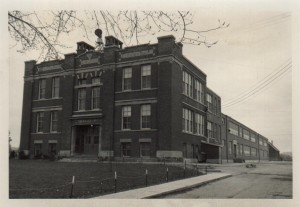 The picture to the left was taken in 1967. There are a few interesting things to note. First of all, the air raid siren can be seen on the top of the school. As mentioned previously, this siren was put on the top of Hillcrest by the Canadian government. To the right hand side of the school, there is a big space where Hillsdale is located today. In 1967, this was used as the Hillcrest teachers parking lot, since there was no Hillsdale. Today, this is part of the land that makes up Hillsdale Elementary School, which was completed in 1971.
The picture to the left was taken in 1967. There are a few interesting things to note. First of all, the air raid siren can be seen on the top of the school. As mentioned previously, this siren was put on the top of Hillcrest by the Canadian government. To the right hand side of the school, there is a big space where Hillsdale is located today. In 1967, this was used as the Hillcrest teachers parking lot, since there was no Hillsdale. Today, this is part of the land that makes up Hillsdale Elementary School, which was completed in 1971.
Since 1967 was Canada’s Centennial Year, many individuals and organizations had reason to celebrate and to mark the occasion. The school board was no different. Special badges, and awards were given to athletes who ranked first, second, and third in their events. This is a first place award given to former student, Tom Mobley in 1967.
On December 9th, 1970, Hillcrest received a notice that stated the address of the school would change from 2130 Barton Street East to 460 Melvin Avenue. This change was to take place officially on the 1st of January, 1971. The Grade two students at Hillcrest Elementary School objected to this plan, so they decided to write a letter of petition to the Mayor, Vic Copps. This made big news, and there was actually an article written about this whole event in the Hamilton Spectator. Eventually, the address was changed to the present 460 Melvin Avenue.
In June of 1971, Hillcrest had a visit from a very famous Canadian. Bobby Gimby, also known as “The Pied Piper Of Canadian”, entertained the students in the gym at Hillcrest with some of his music. The students at Hillcrest sang along, and danced to his tunes. Gimby was most famous for writing Canada’s centennial song called “Canada”. His appearance made news in all of the area papers.
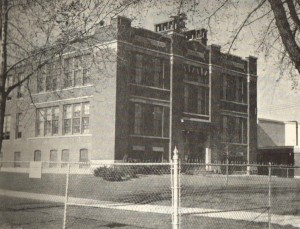 The first Hillcrest yearbook was completed for the 1973-1974 school year, under the supervision of Miss Warrington. The yearbook was dedicated to Mr. George H. Walker, a former principal at the school. The yearbook discusses an interesting Hillcrest School Award System. Students were able to earn certificates of merit. This could be done by showing excellence in subjects, sports, or any other activity such as refereeing, or helping out. These carried over until a student graduated from Hillcrest. When a student had earned 30 Certificates of Merit, they became elgible to receive a School Letter. The highest award that a student could earn was the School Pin. This was given to Grade 8 students who had earned more than 30 Certificates of Merit, and who had also shown a high degree of Scholarship, Effort, and Citizenship throughout their Grade 7 and Grade 8 years. The following shows the School Pin and School Letter, courtesy of Lainie Lanto, a former Hillcrest student. During the 1973-74 year, Hillcrest consisted of Grades 5,6,7, and 8. This included 700 students and 31 teachers.
The first Hillcrest yearbook was completed for the 1973-1974 school year, under the supervision of Miss Warrington. The yearbook was dedicated to Mr. George H. Walker, a former principal at the school. The yearbook discusses an interesting Hillcrest School Award System. Students were able to earn certificates of merit. This could be done by showing excellence in subjects, sports, or any other activity such as refereeing, or helping out. These carried over until a student graduated from Hillcrest. When a student had earned 30 Certificates of Merit, they became elgible to receive a School Letter. The highest award that a student could earn was the School Pin. This was given to Grade 8 students who had earned more than 30 Certificates of Merit, and who had also shown a high degree of Scholarship, Effort, and Citizenship throughout their Grade 7 and Grade 8 years. The following shows the School Pin and School Letter, courtesy of Lainie Lanto, a former Hillcrest student. During the 1973-74 year, Hillcrest consisted of Grades 5,6,7, and 8. This included 700 students and 31 teachers.
In the late 1970s, Hillcrest had many clubs. These includes the Camera Club, Industrial Arts Club, Chess Club, and a Library Club. Also, Hillcrest had its own bowling league. They would meet one day after school at 4:00, at Skyway Lanes on Melvin Avenue. Also, during the late 70s and into the 80s, Hillcrest would have a yearly event called Spirit Week. This week long event was done in order to get all children involved in the Hillcrest spirit! Events included a rumage sale, scavenger hunts, female teachers vs female students in blind volleyball and deck tennis, barbecues, male students vs male teachers in bordenball, hat day, open house, movie day, and was always capped off with a Spirit Week Dance for the students.
Also in 1988, Keith Allen Townsend, a Grade 8 student painted a portrait of Hillcrest at the age o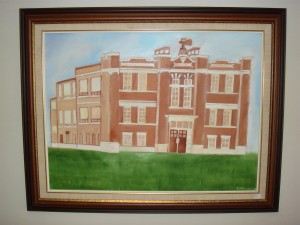 f 13. This portrait remained in the Principal’s Office until the school officially closed in 2006.
f 13. This portrait remained in the Principal’s Office until the school officially closed in 2006.
On December 3rd, 1996, Hillcrest welcomed another famous individual. This time, it was former professional boxer, George Chuvalo, who had once fought boxing legend Muhammad Ali. Chuvalo talked to 200 Grade 7-8 kids at Hillcrest about the ups and down of his life. His stop at Hillcrest was a part of his crusade against drugs. His visit left the students at Hillcrest with a lot of think about.
As early as 1999, there was talk that Hillcrest would be closing. There were many rumours in the years after that, however, none of them turned out to be true. Finally, in the fall of 2003, the Hamilton-Wentworth District School Board announced Phase 2 of their School Revitalization Plan. This phase would last from 2004 to 2008, and would see nine schools built. Part of this plan called for a construction of a new school beside Hillcrest, while the current sites of Hillcrest and Hillsdale would remain open during the construction of the new facility. The new building was scheduled to open in September of 2006 as a Kingergarten to Grade 8 school. Hillcrest and Hillsdale would then be torn down.
Construction of the new Hillcrest/Hillsdale school started in the summer of 2005. In the fall of 2005, students and their parents were asked to help name the new school via a letter home and submission process. 21 votes were cast for the name Crestdale. It was suggested that this name would be most fitting as it combined the names of the two schools who would be joining as one. 20 votes were cast to keep the school name as Hillcrest. In a Board of Education meeting in June of 2006, after some debate, the trustees voted to keep the name Hillcrest. The main consideration was the history of the Hillcrest building, and surrounding area.
On June 17th, 2006, Hillcrest and Hillsdale schools had a closing celebration. The celebration started at 10AM and finished at 3PM. The teachers at both schools organized decade rooms, and former students were invited to tour through both schools. There were many honoured guests, one of which was former student Dan Harris who came all of the way from Scotland for the occasion. Also attending was Mary Moore, who went to Hillcrest when the building originally opened in 1920.
Around this same time, it became apparent that the new Hillcrest would not be ready for September 2006 as planned. The construction was approximately 4-6 weeks behind schedule. This posed a problem. The old building would be demolished starting in July of 2006, therefore, the students could not stay in it. Hillsdale School was not be big enough to handle both schools. Therefore, a decision was made to send the kids to the former Prince of Wales Elementary School on Lottridge Street. The students and teachers would be there from September 5th – October 3rd, 2006. Students would remain at the school doing alternative activities on October 45h, 5th, and 6th while the teachers would use these three days to prepare their classrooms in the new building. Hillcrest Elementary would not officially open its doors until Tuesday October 10th, 2006. This news was conveyed to the parents in a letter that was sent home with each student.
In July of 2006, the demolition of the original 1920 Hillcrest began. Before the outside of the building could be brought down, workers had to tear down the inside of the building. During the demolition process, some of the tunnels that spanned the school below the surface were exposed. More interesting than that was the surprise that awaited in the cornerstone, something that had not been since 1920!!
Towards the end of August 2006, when the majority of Hillcrest had been torn down, the demolition crew turned their focus towards Hillsdale. Hillsdale was completely knocked down by the third week of Septemeber 2006.
Meanw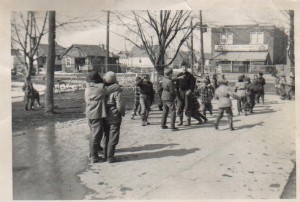 hile, 500 Hillcrest students had to be bussed daily to the Prince of Wales site on 40 Lottridge Street beside Ivor Wynne Stadium. Their first day of school was September 5th, 2006. Staff and students were told that they would only be at this location one month until the new Hillcrest was ready to open. The new school was scheduled to open on October 10th, 2006. While at the Prince of Wales site, “Hillcrest” set uup their entire library, and half of their computer lab and ran the school under a “business as usual” mentality.
hile, 500 Hillcrest students had to be bussed daily to the Prince of Wales site on 40 Lottridge Street beside Ivor Wynne Stadium. Their first day of school was September 5th, 2006. Staff and students were told that they would only be at this location one month until the new Hillcrest was ready to open. The new school was scheduled to open on October 10th, 2006. While at the Prince of Wales site, “Hillcrest” set uup their entire library, and half of their computer lab and ran the school under a “business as usual” mentality.
In the late 1940s, the population of Hillcrest was 269 students. In 1966, the student population at Hillcrest was a whopping 834. Today, Hillcrest has around 380 students.
Updated on Tuesday, May 18, 2021.